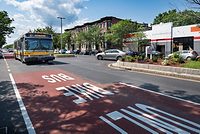
Henrik Virro, project manager of Stockholm LokalTrafik (SL), which operates the metro, buses, commuter and local trains, directed an IP-based system that includes thousands of cameras and integrates with myriad business systems to provide a safe and secure trip to riders.
Security Magazine talked with Henrik Virro, project manager of Stockholm LokalTrafik (SL), which is responsible for operating the metro, buses, commuter and local trains. With a vision for the people of Stockholm to choose public transit over cars, it is the mission of SL to develop and find new solutions for the public transportation system that meets passenger needs for a simple, reliable, cost-effective safe and secure journey. SL has a comprehensive public transit system with approximately 100 train stations and more than 2,100 buses. Virro got the word from his CEO, Lennart Jangälv, who said, “We need to provide our passengers a journey where they know that violence is detected.”
Security Magazine:What was your plan?
Virro:The aim was to have Stockholm LokalTrafik converge multiple systems over an IP network to increase security for buses, subways and train stations.
Security Magazine:What were the challenges?
Virro:Vandalism on buses and in train stations as well as robberies of transit drivers was causing passenger safety concerns. As a result, ridership was not meeting targets. SL was looking for a solution that would deter these types of activities, provide police with evidence of crimes and convince the people of Stockholm that public transit is a convenient and safe alternative to driving.
Security Magazine:How did the plan roll out?
Virro:The vision of SL was to have one common system for all video and safety alarms. Visual Defence provided SL with a command and control center or what we call 3C, a video and event manager and software platform as the system core. The system needed to be able to integrate with existing cameras and security subsystems as well as provide the flexibility and scalability to handle future requirements.
Each of the more than 2,500 station cameras are transmitted over an IP network to the 3C server system. As an open architecture platform, the 3C also provides SL with a single point of management for all subsystems and edge devices including video analytics, fire alarm, intrusion detection, access control, IP intercom help phone, driver alarms, scheduling and mobile digital video storage for approximately 10,000 cameras.
The 3C software handles the complex environment of the camera system. It is integrated with safety alarms so that when an alarm occurs, we can connect the right camera to the alarm.
Security Magazine:What about budget?
Virro:We have seen ROI in increased ridership and revenues. Another idea we’ve considered is using the security infrastructure for additional applications (i.e. revenue generation, marketing, operations, etc.) to create additional ROI. After all, the cameras are installed – why not use them for as many different applications as possible?
Security Magazine:What about compliance?
Virro:This is still a significant concern. However, the security event management module makes compliance easier. Not only are we able to integrate compliant procedures into the system via integrated workflow so that our operators are presented with the appropriate step-by-step instructions for responding to alarms/events, but the reporting functionality makes it very easy to evaluate that the appropriate actions were indeed taken.
Security Magazine:How are employees reacting?
Virro:We’ve found that with the appropriate technology, people issues can be minimized. As mentioned above, an integrated workflow can complement the skills and experience of security personnel, but also creates a situation where new security personnel can be easily and quickly trained for responding to emergency situations. The integrated workflow has allowed us to translate all of our security policies and procedures into step-by-step instructions which really reduced training time and operator skill requirements.
Security Magazine:What is the impact on your customers?
Virro:Certainly, better security can contribute to enhanced public safety which, in turn, can lead to increased customer satisfaction and goodwill. SL used this model to increase public transportation ridership. The idea is that if people are scared to come to SL buses and trains because of violence and vandalism, we lose passengers and ticket revenue. SL needed to provide our passengers a journey where they know that violence is detected as well as prevented, and we feel we’ve achieved that. We feel we have gained back the trust of our customers.
Security Magazine:What are your ideas about convergence?
Virro:Our work has centered on the convergence of our analog and digital technologies. We have heard about the issues with physical security and logical security not getting along; but in our experience at least, the transition and integration have proved very smooth. We did not need to dispose of our analog components, and we could use cameras and other edge devices from any/all vendor of our choosing and integrate them all. We think that convergence technology is the future -- it will only continue to grow in acceptance and adoption.

